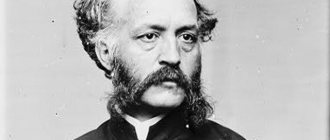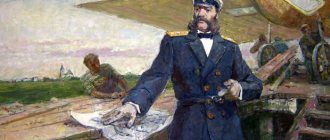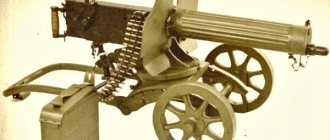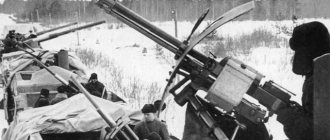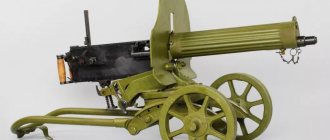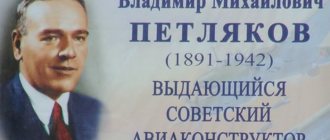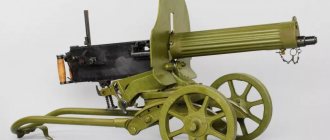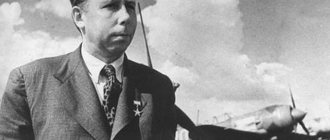After visiting the “Predator” shooting range, I decided to go to the central shooting and sports club ROSTO, which is located very close to my house (Tushinskaya metro station).
At the checkpoint they write down your passport details, then you choose which weapon you will shoot from. The price of a shot is 30-70 rubles. It’s good that they give the targets for free. The instructor is also free. You go up to the second floor. There will be 2 shooting ranges: one large for shooting hunting weapons and one small (25 m) - it is used for shooting from sporting weapons. Looking ahead, I will say that in this shooting range there are no carbines and shotguns - only sporting weapons . Of course, no certificates are needed - just a passport.
I took a revolver, a MTs-58 pistol of 7.62 mm caliber (sports TT), a Margolin pistol of 5.6 mm caliber and a BI-7 rifle with optics. Pistols have lousy accuracy, but the rifle is excellent.
Unfortunately, there was no crossbow and TSV rifle (externally similar to the SVD). In general, it is better to find out in advance if you want to shoot with a particular type of weapon. Their website has outdated information.
Prices
| Revolver TOZ-36 (caliber 7.62 mm) | 50 rub. |
| Revolver TOZ-49 (caliber 7.62 mm) | 50 rub. |
| Pistol MTs-58 (caliber 7.62 mm) | 50 rub. |
| Margolin pistol (caliber 5.6 mm) | 30 rub. |
| Pistol Margo (caliber 5.6 mm) | 30 rub. |
| BI-7 rifle with optical sight (caliber 5.6 mm) | 30 rub. |
| TSV rifle with optical sight (caliber 5.6 mm) | 30 rub. |
| Annschutz rifle (caliber 5.6 mm) | 30 rub. |
| Rifle SM-2 with diopter sight (caliber 5.6 mm) | 30 rub. |
| Rifle Ural-6 with diopter sight (caliber 5.6 mm) | 30 rub. |
Pistol Margo
The Margot pistol was created at the Izhmekh production association in the early 90s on the basis of the Margolin sporting pistol mod. 1948. It differs from the base model by a shorter barrel, the presence of a simple open sight, and the absence of a trigger pressure regulator. Good balancing and a comfortable handle ensure high accuracy of fire. The pistol has a caliber of 5.6 mm. For shooting, small-caliber sporting, hunting and target cartridges of 5.6 mm caliber (.22 LR) are used. A non-jacketed bullet has low penetration and low stopping power.
| Caliber | 5,6 |
| Length, mm | 190 |
| Barrel length, mm | 97 |
| Weight, g | 800 |
| Magazine capacity, pcs. | 8 |
| Sighting range, m | 50 |
| Initial bullet speed, m/s | 200 |
Hunting Gun
Izh BK shotgun. 1935
On April 27, 1920, the demobilization commission of the Central Board of Artillery Factories (TsPAZ) of the Council of Military Industry of the RSFSR addressed the Board of the First Tula Arms Factories with a proposal to immediately send to the commission all proposals on the possibility of establishing the production of peaceful products, in particular hunting weapons. Meanwhile, the head of the ITOZ, Pavel Petrovich Tretyakov, began preparing the plant for the production of civilian products from the beginning of 1918, and in 1919 the hunting workshop was already operating, using the equipment left after the workshop was stopped in 1914. On November 17, 1920, the Council of Labor and Defense issued a resolution “On measures to provide fur hunters with weapons, fire supplies and equipment,” which was signed by Lenin on November 18. The resolution prescribed “...immediately organize the repair and production of hunting weapons at the Izhevsk and Tula factories...”. Obviously, this was a hunting weapon, and the decision was not caused by concern for amateur hunters, but by the need to increase the supply of furs abroad to replenish the treasury.
The Imperial Tula Arms Factory before the revolution.
In addition to blanks and parts from pre-revolutionary production, a large number of Mosin rifles remained unsuitable for military use. Projects to convert them into smoothbore guns were carried out by TOZ engineer P.N. Frolov. Here is what I.A. writes about this. Kondrashova: “The introduction of hunting ramrod, single-shot and repeating rifles designed by Frolov into factory production in the first years after the Civil War is explained by the simplicity of their manufacture. Frolov's ramrod gun was a sample made from defective parts of military weapons. A bushing was screwed into the chamber of a three-line rifle of the 1891 model or a rifle of the 1870 model, and a fire tube was screwed into it. Hunting rifles chambered for rimfire, both repeating and single-shot, were also a conversion system made from defective parts of a three-line rifle. When converting the rifle into a single-shot gun, the designer inserted a barrel with a ground stump and a drilled place for the cartridge head and extractor deep into the magazine window of the receiver, which was closed by a correspondingly bored strap. In accordance with this, the bolt stem, firing pin, and connecting strip were shortened and properly processed. To obtain a repeating gun, in addition, using appropriate linings, a magazine box was adjusted to match the diameter and length of the cartridge. The designer proposed modifying the conventional bolt and drilling a side hole in the combat face for the firing pin, and equipping the firing pin with a side firing pin corresponding to the hole. As a result, a bolt was obtained that allows the use of rimfire cartridges. Both guns were patented after the death of the inventor, in 1927-1928.”
Hunting rifle "Berdanka" based on the Berdan-2 rifle. Photo: Yu. Maksimov
It should be noted that Russian gunsmiths, to put it mildly, did not accept the October revolution with enthusiasm. The production of hunting weapons in the country received a powerful impetus after the announcement of the New Economic Policy (NEP) in the spring of 1921. Banal commercial interest turned out to be much more effective than resolutions and appeals.
Head of the TOZ hunting workshop Dmitry Mikhailovich Kochetov (1897 - 1978). A hereditary gunsmith, whose whole life was connected with TOZ. Worked his way up from a mechanic to a designer. Creator of many types of small arms and hunting weapons, the most famous of which is the TOZ-8 rifle, produced for more than 50 years. One of the organizers of SHOM - a school of weapons craftsmanship.
In 1922, D.M. was appointed head of the TOZ hunting workshop. Kochetov. By this time, from the remnants of the old configuration and decommissioned military weapons, double-barreled center-fire shotguns, single-barreled shotguns with an upper key, berdanks, ramrod single-barreled shotguns and carbines were produced. In 1925, the 16-gauge model “B” began to be mass-produced. At the end of the 30s, it was planned to release the TKS model, which was the same model “B”, but only with spiral mainsprings. The "B" model was also made individually with precision bore drilling, good build quality and improved finish. S.A. Buturlin wrote that “Model B double-barreled guns have become much better in many respects,” since process improvements were introduced in 1936, including soldering barrels in an electric furnace and new precision drilling techniques developed by B.A. Scary. On the 16-caliber model “B” block, 20-caliber guns were produced that “had an excellent fight” (S.A. Buturlin). There were enough Model A parts to make “gift” guns until 1945.
This Model A 24-caliber shotgun bears the marks of ITOZ 1910 and the inscription “First Arms Factories.” The image of the USSR coat of arms has errors (4 ribbons instead of 6), but allows us to set 1923 as the lower limit when attributing the date of issue; the absence of Toz "triangles" on the barrels probably allows us to set 1925 as the upper limit.
12 gauge shotgun with droplocks No. 35. ITOZ stamps of 1910. Came out of the factory after 1925.
Shotgun 20 cal. with droplocks No. 12312, owned by M.S. skeet shooting prof. B.M. Kostyuchenko. ITOS. 1909 Left the factory between 1922 and 1925. Photo: OiOX
However, the rarest gun should be recognized as the Westley-Richards system gun with Deeley-Taylor droplocks, which ITOZ began producing in 1909. It could be ordered in 12 or 20 gauge with varying levels of finish. In 1912, as D.M. recalled. Kochetov, due to lack of demand, this gun was discontinued, which did not prevent the release of a number of shotguns with droplocks in Soviet times, using old equipment and unfinished guns.
Model “R” designed by D.M. Kochetova
In 1925, Kochetov developed a single-barreled gun, called the “Model P”. The barrel of this gun could be a shotgun of 32 or 16 caliber, as well as a rifled 5.6 mm caliber chambered for a side-fire cartridge or a 7.62 mm caliber chambered for a Model 1895 revolver cartridge. The gun's trigger was mounted on the box itself and was closed with a detachable lid. The mainspring is spiral, the trigger has a release and a safety cock. The lock was cocked using a lever on the right side of the box. The birch stock was attached using a tubular shank and a screw. The box had a hinged coupling with a thread into which the barrel was screwed and secured with 2 screws. On the design of this gun D.M. Kochetov received an author's certificate. In 1932, the P model was discontinued and replaced by the IZH-5 model.
Izhevsk arms factory before the revolution.
In Izhevsk, during the civil war, the arms factory itself and its qualified personnel suffered greatly, especially after the suppression of the Izhevsk-Votkinsk uprising of 1918 by the Reds. In August 1921, it was decided to resume production of hunting weapons. The former Evdokimov factory produced the first batch of Berdan guns in November. In 1922, it was reorganized into the 1st State Factory of Hunting Rifles, subordinate to the People's Commissariat of Local Industry of the RSFSR. Production was based on the disposal of defective and obsolete rifles allocated by the People's Commissariat of Defense and the People's Commissariat of Defense Industry. On June 1, 1923, the factory was transferred to self-financing. In 1925, 220 people worked at the facilities expanded by the agricultural machinery factory, who assembled more than 800 guns of seven models every month, including the Webley, Dau and Piper systems (N.L. Izmetinsky, L.E. Mikhailov, “Izhevsk weapons” , 1995). Since 1926, the hunting rifle factory was part of the Udmurttrust (Udmurt Industrial Combined Trust).
Izhevsk The 1st State Factory of Hunting Rifles was located in the premises of the former factory of A.N. Evdokimov.
Komsomol members of the 1st State Factory of Hunting Rifles with their products.
On April 13, 1922, the recreated IOZ hunting rifle workshop began its activities with the production of shotguns based on the Berdan rifle. Soon the production of hammerless double-barreled shotguns of the Pieper system resumed. Shotguns and rifled Siberian rifles with capsule locks were also produced. In the summer of 1926, production began of the IZH-5 single-barreled shotgun, a modernized American shotgun, initially produced under the name “Izhevsk-Johnson” in different calibers: from 12 to 28. In 1926, 8,100 pieces were produced, in 1929 - 80,054 pieces, and in 1934 - 212672 pieces. Models 2 and 3 of the A.A. sporting rifle were also produced. Smirnsky. In 1924, the factory (workshop) of the Regional Union of Hunters was opened, and in 1930 the Dynamo weapons factory began operating. In May 1930, representatives of the German arms industry visited Izhevsk. The conversation included assistance in organizing the production of modern hunting weapons. In 1931, the production buildings of the 1st State Factory of Hunting Rifles were transferred to IOZ (plant No. 10), and the equipment and materials were transferred to the Dynamo factory, where in 1934 more than 34 thousand hunting rifles were manufactured by a small team of 172 people (N L. Izmetinsky, L. E. Mikhailov, “Izhevsk weapons”, 1995).
Shotgun IZH-5: 1-strike; 2- striker spring; 3-trigger; 4-trigger; 5-trigger spring; 6-pusher; 7-spring.
Changes in economic policy can be traced by the change in the name of the Tula arms factory: First arms factories R.S.F.S.R. GAU NK for military affairs of the RSFSR (October 31, 1918 - 1919), The first weapons factories of the Central Board of Artillery Factories of the Council of Military Industry of the RSFSR (1919 - 1922), The first weapons factories of the Main Directorate of Military Industry of the Supreme Economic Council of the RSFSR (1922 - 06/08/1923), The first weapons factories factories of the USSR of the Military Industry Production Association "Voenprom" VSNKh (06/08/1923 - November 1926), The first weapons factories of the USSR of the State Arms and Machine Gun Trust "Rouge" VSNKh (November 1926 - 1930), The first weapons factories of the State All-Union Gun - Weapons - Machine Gun Association Supreme Economic Council of the USSR (1930 - 01/05/1932), The first weapons factories of the Main Military Mobilization Directorate of the People's Commissariat of Heavy Industry of the USSR (01/05/1932 - 1934), The State Union First Weapons Plant - since 1934. The collapse of the NEP and the transition to a planned economy with the beginning of the first five-year plan (1929 - 1933) briefly postponed the issue of creating a domestic hunting rifle. Over time, attitudes towards amateur hunters themselves and their needs began to change for the better. If the first hunting organizations appeared spontaneously and existed for the most part in the Universal Education system, created in 1918 for the on-the-job training of the mobilization reserve of the army, then in the early 20s territorial organizations of hunters began to emerge. At the end of 1921, hunting and fishing commissions appeared in military districts. Since April 1930, the magazine “Fighter – Hunter” began to be published, with which S.A. collaborated. Buturlin. On October 17, 1933, the Revolutionary Military Council of the USSR decided to create the All-Army Military Hunting Society and its branches in the districts. In May 1934, the first conference of military hunters took place in Moscow. I think the importance of hunting in terms of preparation for military service was deliberately exaggerated, but there seemed to be no other way to revive amateur hunting in the country. During the time of the planned economy, perhaps only the All-Army Military Hunting Society, which in 1937 had more than 40 thousand members in its ranks, its own shooting sports and its own printed organ, could at the appropriate level voice the problems of hunting enthusiasts, among which the first place was lack of modern domestic hunting rifles.
And such a gun appeared in 1932 in Izhevsk under the name Izh BK. The author is considered to be a technician at the arms factory Morozov*. The design work was carried out by senior designer A.V. Azyabin under the leadership of engineer A.S. Butakov, who was subsequently responsible for the resumption of the production of hunting weapons in the Soviet zone of occupation of Germany.
*This surname was named by V.E. Markevich, but neither the fate of this man, nor even his initials are known. The Tula State Weapons Museum houses a single-barreled 16-gauge shotgun designed by Morozov, assembled in the IOZ hunting rifle workshop in 1931.
Morozov single-barreled shotgun 16 caliber. 1931
“The barrel of the gun is cylindrical, with a coupling in the breech, folds down, and is detachable. The barrel bore is locked by a frame that fits into the recess of a large under-barrel hook. The release lever is lower, the tail part is combined with the trigger guard. The sighting device consists of a round front sight and a slot on the top of the receiver. The receiver is cranked, with a straight rear edge; There is a safety button on the shank. The trigger is internal. An extractor in the form of a shaped plate with a cylindrical rod. The stock is wooden, consists of a short detachable forend with a lever latch, a semi-pistol neck and a flat butt. On the top of the breech is stamped: 16 k., Izhev. plant., 1931, Morozov's gun; on the hinge of the forend - 1. A floral ornament is engraved on the receiver, trigger guard, and latch of the forend” (museum-arms.ru).
The prototype of the Izh BK was a gun under the Lepage brand from Kaufmann J. & Cie from Liege. The owner of the company, Jules Kaufmann, relied on the production of cheap machine-made shotguns.
Izh BK prototype - a gun under the Lepage brand from Kaufmann J. & Cie
In 1934, the first batch of 500 Izh BK guns went on sale. This happened after the hunting rifle workshop of the Izhevsk Arms Plant was transformed into a hunting rifle workshop (order of the plant director P.A. Maksimov dated October 15, 1934), where, along with IZH-5, they began to produce Izh BK in a small series.
Izh BK shotgun.
Izh BK gun lock.
The Izh BK 16-caliber double-barreled shotgun weighs about 3 kg, the barrel length is 700 mm, and the chamber length is 70 mm. The gun is locked with a single bottom hook and a Greener bolt. Forend - push-button, Anson system. The locks are mounted on the side bases, do not have spoilers, and the mainsprings are spiral. A non-automatic safety locks the triggers. The shutter is driven by the top key. The cocking mechanism also operates from it. It was believed that such a solution would make the block as durable as possible. As a result, the force on the key reached 17 (!) kg. Attempts to weaken the spring resulted in an acceptable force of 11-12 kg, but at the same time the number of misfires sharply increased. Be that as it may, the few IZH BCs that have survived to this day work quite well, without causing any complaints from their owners. In 1937, this brand of gun was discontinued. I have no information that besides the 16th IZH BC it was produced in other calibers.
In 1936 A.V. Azyabin and A.S. Butakov developed a new gun - a horizontal cage-type gun, called IZH B-36. The launch of mass production of the new gun was delayed. In January 1937, the first 15 pieces were made, in February - 60. In March 1937, the gun began to go on sale. Double-barreled shotgun IZH B-36 12 gauge, weighs from 3.5 to 3.7 kg, barrel weight 1690 g, barrel length 710 mm, chamber length 70 mm. The gun is locked with two under-barrel hooks and a Greener bolt. The locks are mounted on the side bases, have interceptors that intercept the triggers, and two-leaf mainsprings. The safety locks the triggers. The shutter is driven by the top key. The locks are cocked when the gun is broken. Forend - push-button, Anson system. The gun has a wide guilloche rib. S.A. Buturlin considered the IZH B-36 “a solid, comfortable, intelligently built gun with a reliable bolt, good locks, a strong barrel profile and an excellent stock shape.”
Shotgun IZH B-36.
Gun lock IZH B-36
Surprisingly, in the not so long history of IZH guns there are still many “blank spots”. In the 1937 catalog, in addition to the IzhB-36 gun, the IzhBK-36 gun, production of which began in January 1936, is described. The famous gunsmith Fyodor Kapitonovich Charsky mentioned the IzhBK-35 model. Everyone has yet to figure this out.
By 1932, the TOZ hunting workshop was transformed into a hunting weapons workshop. In 1934, under the leadership of the oldest gunsmith A.D. Ivanov produced several guns for the All-Union Industrial Exhibition. They received high praise from such eminent hunters as Voroshilov and Budyonny. In 1935, a non-hammer with spiral mainsprings was demonstrated to the commission of the Central Bureau of Quality of the People's Commissariat of Heavy Industry during an inspection of the plant. Only in 1937 did the new gun go on sale. S.A. Buturlin wrote that this required 3–4 years of industry work together with “the hunting community represented by the permanent commission on hunting weapons” (S.A. Buturlin chaired the commission on hunting weapons of the Committee of the North under the Presidium of the All-Russian Central Executive Committee). It is still unknown what exactly this gun was called (the name TOZ 36, which appears in some articles, has not been confirmed by anything). The hammerless Tula gun was produced in 16 and 12 calibers. The weight of a 16 gauge shotgun is 3.2 kg, the weight of the barrels is 1450 g. with a length of 695 mm. The weight of a 12 gauge shotgun is 3.7 kg, the weight of the barrels is 1800 g. with a length of 722 mm, chamber length 70 mm. The choke constrictions are chokes in both barrels. The gun is locked with two under-barrel hooks and a Greener bolt. The locks are mounted on the side bases and do not have interceptors. The mainsprings are spiral. Inside the spring there is a pusher stem, which is connected to the trigger. The mainsprings and pushers are located in cylindrical channels inside the bolt box cushions. When breaking the gun, the groove in the end part of the forend (push-button, Anson system) interacts with the arm of the rocker-supercharger, which, turning with its other arm, interacts with the pusher head, which has an inclination of 45 degrees. The pusher cocks the hammer, simultaneously compressing the mainspring. A non-automatic safety locks the triggers. The shutter is driven by the top key. The gun has a guilloche rib with a slightly concave profile. A few words about the finishing of the Tula beskovkovka. On the side bases of the gun, the figurine of a flying woodcock is made using the defensive technique with a slight lowering of the background within the picture. The “bottom” of the box is cut deeper. It depicts a deer against the backdrop of a forest landscape. The upper part of the block and the key are decorated with chasing in the form of flower bouquets. The work is quite professional and delicate, in any case, no worse than what we are used to seeing on most captured and reparation German guns. All this is well complemented by excellent quality colored tracing paper. The draft was done flawlessly.
Tula hammerless shotgun 12 gauge.
A few words about the shortcomings. The main and main ones are too heavy barrel blocks. Before the war, the barrels of all the above-mentioned domestic guns were made of good quality weapon steel No. 6 ½. Therefore, it is unlikely that the excess weight was caused by the low strength characteristics of the barrel material. It can be assumed that the method for calculating wall thickness was not so perfect, but there is another assumption. During the years of mass repression, perhaps the designers were simply playing it safe, fearing accusations of sabotage. By the way, spy mania and the search for internal enemies affected the reliability and availability of information. Therefore, one should not be surprised that Markevich’s data on domestic guns does not coincide with Buturlin’s data, and in general this whole issue turned out to be a real “blank spot”.
Lock and trigger mechanism of a Tula hammerless gun.
Let's return, however, to the shortcomings. The pusher in Tula guns is pivotally connected to the trigger by means of an earring and a screw. You can get to this screw through a small hole in the side base, plugged with another screw. Manipulations of connecting the earring and the trigger require the precision and dexterity of a watchmaker, and not a fitter. Among other shortcomings, the lack of interceptors should be noted. The chambers are drilled for folder cartridges, although in earlier times hunters preferred metal ones, which they took care of and used many times. In this sense, the absence of ejectors was more of an advantage than a disadvantage. Shooting a 12-gauge shotgun with modern non-container cartridges at 35 meters showed good alignment of the barrels and very average quality of the shot pellet. There is another model of a Tula hammerless gun of a similar design. The only difference is that cocking occurs when the receiver block is lowered onto two levers protruding from the bolt box cushions. This mechanics provides a “self-opening” effect.
Shotgun 16 cal. with “self-opening” effect No. 108. TOZ. It was presented by the Soviet Government to a full member of the USSR Academy of Sciences, the head of Dneprostroy, Alexander Vasilyevich Winter, in connection with his 60th anniversary. Photo: Boguslaev Technology Museum (Zaporozhye).
Shotgun 16 cal. with “self-opening” effect No. 67. TOZ.
The same shotgun No. 20 with a memorial finish. First photo from above: master-gun.com
The same 20 gauge shotgun. Photo: master-gun.com
Two copies of this gun are known and described, having a memorial finish (see Master Gun, Nos. 137 and 154). One is 16 gauge, the other is 20 gauge, weighing 3 kg with barrels 720 mm long, assembled on the same block. Thematic engraving on the side bases reflects important events in the life of the country and the plant: the 1933 Moscow-Karakum motor rally, the rescue of the Chelyuskinites in 1934, the famous Dzerzhinets milling machine, mass-produced since 1932 on the premises of the current Mashzavod, which was part of TOZ , a TT pistol, mass production of which also began in 1933. A funny mistake was made by the authors of the article in the magazine “Master Gun”. “Long with towers and TOZ inscriptions” is not a factory stadium, but an image of a spinning water machine that TOZ produced. Those who consider such engraving work primitive are deeply mistaken. It is “primitive” exactly as much as “primitive” are, for example, the works of Russian avant-garde artists. The spirit of the times is wonderfully emphasized by the inscription on one of the guns: “Comrade. Ivanov from the triangle of workshop No. 3. 1st state plant in Tula.” Let me make a few assumptions. First: “Comrade. Ivanov” is Alexander Dmitrievich Ivanov, the oldest Tula gunsmith, TOZ gunsmith of the 1st category, who headed the Tula arms school in 1918–1919. Second: A.D. Ivanov is the author of the Tula hammerless jackets. I think it was they who were shown to Voroshilov and Budyonny in 1934. The self-opening model was never mass produced. Tula hammerless rifles had the same numbering. All numbers of guns known today are within two hundred.
This 20-gauge Model B shotgun was produced by TOZ in 1938 on the block of a 16-gauge shotgun. Photo: guns.ru
The country was preparing for war. The militarization of industry could not but affect the production of hunting weapons. "Council of People's Commissars of the USSR. March 15, 1938 Moscow, Kremlin. Secret. The People's Commissariat of Defense Industry of the USSR, in connection with the cessation of the production of hunting rifles at plant No. 180 of the People's Commissariat of Defense Industry, submitted proposals to the Economic Council under the Council of People's Commissars of the USSR to transfer the production of hunting rifles to the People's Commissariat of the local industry of the RSFSR. The Council of People's Commissars of the RSFSR, having considered this issue, reports that the hunting rifle factory in the city of Izhevsk, located in the system of the People's Commissariat of Industry of the RSFSR, currently produces hunting rifles (single-barrel) from rejected and obsolete rifles allocated by the People's Commissariat of Defense and the People's Commissariat of Defense Industry of the USSR. The production of modern IZH-5 hunting rifles can be organized at this factory in quantities of up to 50 thousand units per year, subject to the following measures: b) obtaining the necessary equipment from the factories of the People's Commissariat of Defense Industry, which have liquidated the production of hunting rifles; c) supplying the hunting rifle factory from plant No. 180 with finished barrels for 2 years in the amount of 50 thousand pieces per year. The Council of People's Commissars of the RSFSR does not object to the organization of the production of hunting rifles at the Izhevsk factory of the USSR People's Commissariat of Industry and the transfer of unfinished construction from plant No. 180 of the People's Commissariat of the Defense Industry to this factory... and asks to oblige the People's Commissariat to transfer to the Izhevsk factory from plant No. 180 all the equipment of the workshop for the production of hunting rifles. Chairman of the Council of People's Commissars of the RSFSR Bulganin." "G. Moscow. July 1, 1938 Not to be made public. Order of the People's Commissariat of Local Industry of the RSFSR No. 448 “On approval of the design assignment for the construction of hunting rifles in Izhevsk.” 2. The plant’s production program should be approved in the following form: 1) Hunting rifles of the IZH-5 brand – 200,000 pcs. 2) Hunting rifles brand IZH-B-36 – 2500 pcs. 3) Small-caliber rifle TOZ-8 – 40,000 pcs. 5. Establish that the construction of the plant should be carried out in such a way that, first of all, the unfinished building of the All-Kopinsoyuz is completed and the necessary equipment is installed, ensuring the production of at least 100,000 hunting rifles of the IZH-5 brand. Deputy People's Commissar of Local Industry of the RSFSR Zhukovsky." Tozov guns were produced until the start of the war. Although the production of the trigger model was transferred to the hunting rifle factory of the production artel named after. Volodarsky, TOZ itself, according to the memoirs of D.M. Kochetov, continued to produce IZH-5 shotguns. There are custom shotguns with 1941 hallmarks, including a shotgun with droplocks. This gun was manufactured in 1911 and only finished in 1941.
Shotgun TOZ No. 910-41 with droplocks.
Activities of the hunting rifle factory of the production artel named after. Volodarsky has never been studied by anyone, therefore the data that I present below should be treated as preliminary information. The factory was probably started in August 1939. A new 2-story building was built for it at the address: st. Demidovskaya 47 with an area of 2500 square meters. The role of the lock and hardware plant of the People's Commissariat of the Construction Materials Industry, which was located next door, is still unclear. This plant changed its name several times: “Phoenix”, named after. Krylenko, “Tula Lock and Hardware Factory”, “Red October”.
Tula. The building of the hunting rifle factory of the production artel named after. Volodarsky.
Interesting conclusions can be drawn by comparing model B of the artel factory named after. Volodarsky (above) and TOZ model B from 1938.
The production of the 16-caliber model B was transferred to the hunting rifle factory from TOZ. I do not have reliable data on the production of guns of other models. Some personnel of TOZ became members of the artel, including the oldest Tula gunsmith A.D. Ivanov. In August 1941, the artel named after. Volodarsky was still working. At the end of October, German troops approached Tula. On October 30, when a fierce battle was going on on the outskirts of the city, the last train with the equipment of the evacuated TOZ left. By this time, most likely, the artel had already ceased its work. On June 13, 1942, by decree of the Secretary of the Tula Regional Committee of the All-Union Communist Party (Bolsheviks) V.G. Zhavoronkov, the premises of the hunting rifle factory were transferred to plant No. 5 for the production of gas masks, sanitary bags and stretchers. In 1945, this building housed a camp for German prisoners of war (the entire free territory of the Tula Arsenal, located opposite, was given over to the camp).
Extract from the order for the Tula Lock and Hardware Factory on the transfer of A.D. Ivanov at the disposal of the chairman of the artel named after. Volodarsky.
Pass A.D. Ivanova.
Production artel named after. Volodarsky was a link in the industrial cooperation system of the USSR. Such associations were created voluntarily on the basis of collective property for joint work with collective responsibility for its results and participation in the income of the artel. The chairman of the artel was elected by vote of the workers. By a resolution of the Central Executive Committee and the Council of People's Commissars of the USSR in 1932, industrial cooperation was given the task of producing consumer goods using local raw materials and waste. Who and when allowed the artels to them. Volodarsky to produce hunting weapons, and how the production process was organized remains to be seen.
Price list pages of the hunting store N.M. Erikalova. Leningrad. 1927
It should be noted that the production of hunting weapons in Soviet Russia was the prerogative of the state, which, however, did not prevent entrepreneurs from producing various hunting accessories during the NEP. In addition, private gun stores were allowed, as well as workshops for repairing hunting weapons.
Share this:
Liked this:
Like
Similar
MCM
The Margolin Target pistol, chambered for the .22 “long” cartridge, developed by Margolin in 1948 at the Izhevsk Machine-Building Plant, is still considered one of the best sporting target pistols in the world. Its parameters correspond to a standard class pistol for competitions according to the rules of the International Rifle Union.
| Caliber | 5,6 |
| Length, mm | 245 |
| Barrel length, mm | 130 |
| Weight, g | 900 |
| Magazine capacity, pcs. | 5 |
Rifle Ural-6
Designed for sport shooting at a distance of 50 m in prone, standing, and kneeling exercises. For firing, 5.6 mm (.22LR) rimfire cartridges are used. The parameters of the bore, chamber and locking unit are selected so that the rifles operate equally reliably on both domestic and foreign cartridges.
| Caliber | 5,6 |
| Length, mm | 1150 |
| Barrel length, mm | 680 |
| Weight, kg | 5.5 |
sm-2s rifle
The rifle is available in several versions; weighing 5 kg; weighing up to 3.6 kg (cadet), with a safety lock, with a left-handed stock, and also in a combination of these designs. All versions are created on a single design basis and are intended for sports shooting in prone, standing, kneeling exercises in competitions at a distance of 50 m and are recommended for women and juniors.
| Caliber | 5,6 |
| Length, mm | 1118 |
| Barrel length, mm | 680 |
| Weight, kg | 5 |
Khaidurov's weapons have had a significant impact on the world market
And it’s not surprising: since 1966, it has brought success to all USSR speed shooting champions and the vast majority of medalists. With its help, all the country's records were set (including A. Kuzmin's result with XP-79 - 600 points out of 600 possible), a number of European and world achievements, and all records for women without exception.
The 1988 Olympic Games in Seoul are especially memorable for Efim Leontyevich, where all types of pistol competitions were won using weapons of his design - Tula and Izhevsk. This does not go unnoticed.
The victories of our shooters forced the above-mentioned Swiss company, the world leader in the production of sporting weapons, to “make room” in the market. As a result, many foreign enterprises, who had previously had no hope of seriously competing with it, became bolder. And such models appeared, for example, as “Pardini” and “Domino” (Italy), “British-2000” (England), “Sacco” (Finland), “Unic” (France).
TSV rifle
Along with the SVD, Dragunov created the little-known, but very interesting in design TSV, a training sniper rifle chambered for a 5.6 mm rimfire cartridge. In many ways, it copies the SVD, and this is understandable, because its main task is to serve as a training weapon for snipers before they have the opportunity to shoot from real combat weapons. The TSV has a familiar frame stock, barrel linings with six ventilation holes on each side. The box is more concise and short. The trunk is shortened. The operating principle of the firing unit is based on free recoil. The stamp-welded magazine holds 10 small-caliber cartridges.
Strictly speaking, with some stretch it can be classified as a “real” sniper rifle due to insufficient accuracy at ranges of more than 100 m (from a distance of 50 meters, an experienced shooter from a prone position is able to hit a target with a diameter of 12 mm with a series of 10 shots). This is a training rifle and was produced in a small batch.
Since 1984 Efim Leontievich
Since 1984, Efim Leontyevich became a senior coach at the Central Shooting and Sports Club of the Russian Federation. In 1986, he completed the design development and manufactured a prototype of a modern air rifle for mass shooting training of schoolchildren and pre-conscripts. What about pistols? All attempts by sports organizations to restore production of IZH-HR-30 and “31” were unsuccessful.
Khaidurov’s former co-author V.A. Razorenov began working separately: in 1992 he modernized the “30” model, making a number of changes based on the KHRB-88 model. Having assembled a standard pistol in this way, he sold the rights to manufacture it to a German company, which planned to start producing it under the AW-93 brand. But Vladimir Alexandrovich himself had died by that time...
Sports pistols IZH
Developed by the greatest designer of sporting weapons, Khaidurov. Starting from the mid-50s, he was actively involved in bullet shooting, was a member of the USSR national team, a winner of the World and European Championships, and was a World Champion as part of the team. Then he, being a “pistol pilot,” came to the conclusion that shooting from a Margolin pistol and showing top results at Championships was simply unrealistic. He started inventing. And to date he has invented 15 major models.
His pistols are also very popular abroad. XP-30, XP-31, IZH-34. Pistols for rapid fire are also all his. He also invented two large-caliber revolvers - TOZ-36 and TOZ-49, and, by order of DOSAAF, he designed the PVSh-1 school air rifle.
In 1967
In 1967, Khaidurov became the senior coach of the pistol group of the USSR shooting team. The group successfully performed at the Olympics in Mexico City in 1968, and 6 years later at the World Championships they won 12 out of 14 gold medals in pistol exercises. Coaching experience made their design work even more effective. In 1968, the XP-64 passed state tests, during which it significantly exceeded existing analogues in all respects.
For mass production, Khaidurov and Razorenov developed on its basis unified pistols IZH-HR-30 and IZH-HR-31 - standard and arbitrary, respectively, for regular and shortened small-caliber cartridges. The last of these two models was initially equipped with a number of additional original solutions that significantly improved its characteristics. True, when they were put into series, they were abandoned for reasons of unification.
But even in this version, the new pistols became the most popular among Soviet shooters, and not only among them. Khaidurov’s weapons have long been talked about with respect abroad. Back in 1967, the West German magazine Deutscheschützenzeitung published reviews from Swiss representatives about the new paths in the design of sports weapons outlined by Izhevsk models. And in 75-76, Deutsche-Waffen Magazine (Germany) published a series of articles “Russian XP sports pistols with us,” with a detailed analysis of their design features and test data.
The conclusions were the most flattering: “In terms of combat accuracy and reliability, the XP-30 pistol... serves as a first-class example in technical terms, distinguished by accuracy of fire and trouble-free operation.” It was emphasized that the pistol worked stably with 32 types of cartridges, and with eight it showed accuracy of less than 20 mm! In 1976, Efim Leontievich left his position as national team coach to head the department of shooting sports at the State Institute of Physical Education.
The use of scientific and methodological developments in the field of training shooters again helped to improve weapons. In collaboration with Tula craftsmen, Khaidurov modernized his first pistol, creating the TOZ-35M. Soon he became involved in pre-Olympic efforts, in particular, actively participating in the design and construction of the Olympic shooting range in Mytishchi.
And just before the Moscow Olympics, they were needed - urgently, as always! — new improved modifications of the pistol for high-speed shooting. And the previous Izhevsk discoveries, not embodied in the IZH-XP-31, waited for their implementation - in the XP-79 model.
TOZ-35M is a random (target) pistol. Developed in 1959-1961, produced since 1962 (modified since 1978). Caliber - 5.6 mm. Weight -1200 -1400 g. Firing accuracy (average dispersion diameter) is 25 mm, which is close to the performance of sporting rifles. Equipped with an ejector mechanism (case ejection), as well as a trigger (trigger accelerator) with force adjustment from 5 to 30 g. It has a regulator for the working stroke of the trigger and the position of the latter, depending on the length of the fingers. A unique feature for pistols is that the hook axis can be rotated relative to the vertical plane depending on the desired direction of pressure.
Sports revolvers TOZ-36 and TOZ-49
The TOZ-36 sports revolver was developed by E. L. Khaidurov based on the Nagan revolver mod. 1895. The revolver has the following differences from the base model:
- trunk lengthened
- the shape of the mating surfaces has been changed when the drum runs onto the breech of the barrel
- the attachment point for the drum axis in the revolver frame has been changed
- a new device was used for extracting spent cartridges
- The belt on the drum was removed, by which the protrusion of the trigger pulled the drum back after firing
Based on the TOZ-36, a modification was developed for a shortened revolving cartridge - TOZ-49. It differs from the basic sample in its shorter drum length.

